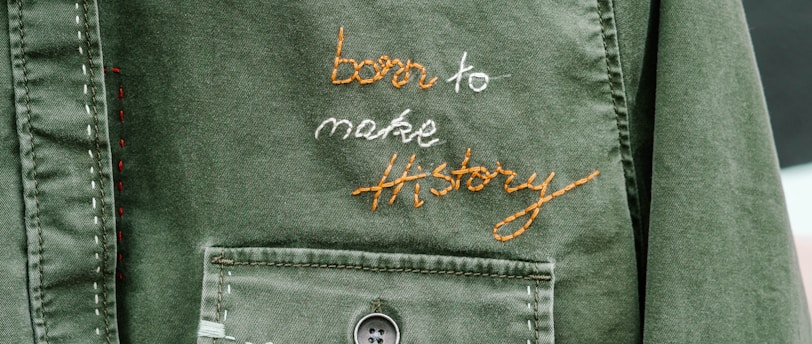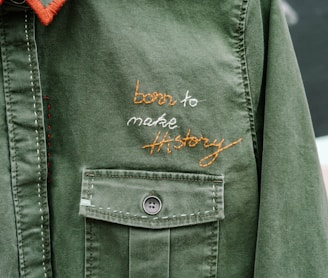Embroidery Customization: A Guide to Personalized Apparel
In this guide, we will cover everything you need to know about embroidery customization, from the basics to advanced techniques, and how it can elevate your personal style.
CUSTOMIZATION OPTIONS
Saleem Shahzad
5/9/20234 min read


Embroidery has been used for thousands of years as a decorative art form, but it wasn't until the industrial revolution that it became widely available for commercial use. Today, embroidery customization is a popular way to personalize clothing and accessories, from hats and jackets to bags and backpacks. Embroidery is versatile, durable, and can add a touch of sophistication to any garment. With the rise of customization and personalization trends, embroidery customization has become an increasingly popular choice for businesses, sports teams, and individuals alike.
How Embroidery Customization Works
Embroidery customization involves stitching a design onto a piece of fabric using a specialized embroidery machine. The design is digitized using embroidery software, which translates the image or text into a pattern of stitches that the machine can follow. The fabric is hooped and the machine needle passes through the fabric, creating the stitches that make up the design. The process can take anywhere from a few minutes to several hours, depending on the complexity of the design and the size of the embroidery.
Benefits of Embroidery Customization
Embroidery customization has many benefits, including:
Personalization
Embroidery customization allows you to add a personal touch to your clothing and accessories. You can choose your own design, logo, or text to create a one-of-a-kind item that reflects your personality and style.
Durability
Embroidery is a durable and long-lasting form of decoration. Unlike other methods of customization, such as screen printing or heat transfer, embroidery will not fade or peel over time.
Professionalism
Embroidery adds a touch of professionalism to clothing and accessories. It is often used for uniforms, workwear, and corporate apparel to create a polished and cohesive look.
Versatility
Embroidery can be applied to a wide range of fabrics and materials, including cotton, polyester, denim, leather, and more. It can also be used on a variety of items, such as hats, jackets, bags, and towels.
Embroidery Customization Techniques
There are several techniques used in embroidery customization to create different effects and textures. Here are a few of the most common techniques:
Satin Stitch
The satin stitch is a classic embroidery technique that creates a smooth, shiny surface. It is often used for lettering and small details, as well as for filling in large areas of color.
Chain Stitch
The chain stitch is a decorative stitch that creates a textured line. It can be used for outlines, borders, and lettering, and can be varied in thickness to create different effects.
Appliqué
Appliqué is a technique that involves attaching a piece of fabric or other material to the base fabric and then stitching around the edges to secure it in place. It is often used for large designs or logos.
3D Puff Embroidery
3D puff embroidery is a technique that involves adding foam under the embroidery to create a raised, three-dimensional effect. It is often used for hats and other accessories to add extra depth and dimension to the design.
Choosing the Right Fabric for Embroidery Customization
When choosing a fabric for embroidery customization, it is important to consider the type of design and the intended use of the garment or accessory. Here are a few things to keep in mind when selecting fabric for embroidery customization:
Fabric Type
Not all fabrics are created equal when it comes to embroidery. Fabrics that are too thick or too thin may not hold up well to the stitching, while fabrics with a loose weave may be more difficult to embroider cleanly. Generally, mid-weight fabrics like cotton or polyester blends are ideal for embroidery.
Color
The color of the fabric can also impact the embroidery design. Lighter fabrics may require darker thread colors to ensure the design stands out, while darker fabrics may require lighter thread colors. It's important to consider contrast when selecting fabric and thread colors.
Texture
The texture of the fabric can also impact the appearance of the embroidery. Smooth fabrics like satin or silk will create a different effect than textured fabrics like denim or corduroy. It's important to choose a fabric that complements the design and intended use of the garment or accessory.
Embroidery Customization FAQs
How long does it take to complete an embroidery customization order?
The turnaround time for embroidery customization can vary depending on the complexity of the design and the quantity of items being embroidered. However, most orders can be completed within a few days to a week.
Can I bring my own design for embroidery customization?
Yes, most embroidery customization companies will allow you to bring your own design or logo for embroidery. You will need to provide a high-quality image or file for the embroidery machine to digitize the design.
What is the minimum order quantity for embroidery customization?
The minimum order quantity for embroidery customization can vary depending on the company, but it is often around 12-24 pieces.
Is embroidery customization more expensive than other customization methods?
Embroidery customization can be slightly more expensive than other customization methods like screen printing or heat transfer. However, the durability and professionalism of embroidery make it a worthwhile investment for many businesses and individuals.
Can embroidery customization be done on hats and bags?
Yes, embroidery customization can be done on a wide range of items, including hats, bags, and backpacks.
How do I care for embroidered garments?
Embroidered garments should be washed in cold water and hung to dry to avoid shrinkage and damage to the embroidery. Ironing should be done on the reverse side of the embroidery to avoid flattening the design.
Conclusion
Embroidery customization is a versatile and durable way to add a personal touch to your clothing and accessories. With a wide range of techniques and fabric options available, embroidery customization can create a unique and professional look that will last for years to come. Whether you're looking to personalize your own wardrobe or create branded apparel for your business, embroidery customization is a great option to consider.
